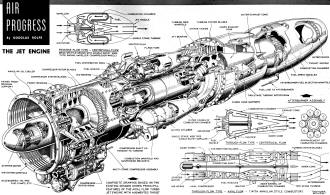|
Turbine jet engines were still a relatively new invention
- at least for commercial airplanes - in 1951. The military was already using them for fighters, but
remember that it wasn't until the end of World War II that jet airplanes were seen in the skies,
so we're only talking about half a decade of progress. Mr. Douglas Rolfe produced this very finely
detailed cross-sectional drawing of a turbine jet engine. It must have taken quite a while to add so
much information. Even using modern CAD software would require a lot of time to generate such a drawing.
The nice thing about CAD is that if you make a mistake or change something, or maybe want to move part
of the drawing to another location on the page, it is a simple matter of selecting the objects and changing
or dragging them as needed. On a drafting board with velum and a pencil, careful erasing was required
and moving entire sections around was a major undertaking. Add to that the fact that the engines were
designed almost entirely with the aid of a slide rule, and it is incredible to behold such works of
engineering.
Air Progress: The Turbine Jet Engine
By Douglas Rolfe

The first practical turbo-jet engine was born in England in April 1937. It was a far cry from the
present-day mighty powerplants which develop over 10,000 hp and are capable of pushing a fighter to
a speed of over 600 mph. The creator of the engine was an RAF officer, Frank Whittle, now Air Commodore,
the man who revolutionized aviation's powerplant field. It is true that the Germans made the first short
hop with a jet-propelled Heinkel He-178 powered by a Heinkel jet engine two years before the Gloster
E28/39 plane powered by the Whittle plant took to the air, but the Nazi engine was abandoned and flights
with a different type were resumed after the Gloster was flown successfully. Whittle's jet was progressively
improved and it was this type that eventually flew the first U. S. jet fighter, the Bell P-59 Airacomet.
As seen from these illustrations, there are several types of turbo-jets. The two main ones are the centrifugal
and the axial flow. The centrifugal has a compressor consisting of a single impeller, while the axial
flow has several located one behind the other and separated by stationary or stator blades which act
as diffusers. Some engines also have multiple-stage turbines. The centrifugal type is further subdivided
into reverse flow and through flow types, as illustrated here. The only advantage of the reverse type
is the reduction of overall length and shortness of the shaft which joins the compressor with the turbine.
Because gases have to make a complete reversal before they strike the turbine, there is considerable
power loss. In fighters, the afterburner is used to increase power by 40% for short bursts of speed.
Douglas Rolfe Drawings
-
Post-Pusher Parade, May 1961 American Modeler
-
Air Progress: The Jet Engine, July 1951 Air Trails
-
Air Progress: The Bristol Story, November 1948 Air Trails
-
Auto
Progress: Down Memory Lane III, December 1954 Air Trails
- Auto
Progress: Memory Lane Collection No. 2, August 1954 Air Trails
-
Air Progress Famous Firsts, August 1954 Air Trails
-
Air Progress: Japanese Air Force World War II Fighters, December 1954 Air Trails
-
Air Progress: Lindbergh Era (1927-1929), July 1954 Air Trails
-
Air Progress: The Search for Speed, November 1950 Air Trails
-
Air Progress: Soviet Air Force Latter Day Types, March 1955 Air Trails
Posted February 21, 2015
|